| Maintenance Service Interval | Maintenance Procedure |
|---|---|
| Before each use or daily |
|
Introduction
This rotary-blade, riding lawn mower is intended to be used by residential homeowners or professional, hired operators. It is designed primarily for cutting grass on well-maintained lawns on residential or commercial properties. It is not designed for cutting brush or for agricultural uses.
Read this information carefully to learn how to operate and maintain your product properly and to avoid injury and product damage. You are responsible for operating the product properly and safely.
You may contact Toro directly at www.Toro.com for product safety and operation training materials, accessory information, help finding a dealer, or to register your product.
Whenever you need service, genuine Toro parts, or additional information, contact an Authorized Service Dealer or Toro Customer Service and have the model and serial numbers of your product ready. Figure 1 identifies the location of the model and serial numbers on the product. Write the numbers in the space provided.
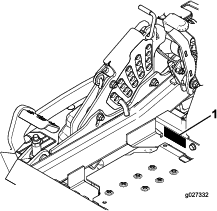
This manual identifies potential hazards and has safety messages identified by the safety-alert symbol (Figure 2), which signals a hazard that may cause serious injury or death if you do not follow the recommended precautions.

This manual uses 2 words to highlight information. Important calls attention to special mechanical information and Note emphasizes general information worthy of special attention.
This spark ignition system complies with Canadian ICES-002
It is a violation of California Public Resource Code Section 4442 or 4443 to use or operate the engine on any forest-covered, brush-covered, or grass-covered land unless the engine is equipped with a spark arrester, as defined in Section 4442, maintained in effective working order or the engine is constructed, equipped, and maintained for the prevention of fire.
Warning
Removing standard original equipment parts and accessories may alter the warranty, traction, and safety of the machine. Failure to use original Toro parts could cause serious injury or death. Making unauthorized changes to the engine, fuel or venting system, may violate EPA and CARB regulations.
Replace all parts including, but not limited to, tires, belts, blades, and fuel system components with original Toro parts.
The enclosed Engine Owner's Manual is supplied for information regarding the US Environmental Protection Agency (EPA) and the California Emission Control Regulation of emission systems, maintenance, and warranty. Replacements may be ordered through the engine manufacturer.
Warning
CALIFORNIA
Proposition 65 Warning
The engine exhaust from this product contains chemicals known to the State of California to cause cancer, birth defects, or other reproductive harm.
Safety
This machine has been desined in accordance with ANSI B71.4-2012.
Improper use or maintenance can result in injury. To reduce the potential for injury, comply with these safety instructions and always pay attention to the safety-alert symbol, which means CAUTION, WARNING, or DANGER—personal safety instruction. Failure to comply with the instruction may result in personal injury or death.
This machine was manufactured according to the appropriate regulatory standards in effect at the time of manufacture. Modifying this machine in any way may cause it to be out of compliance with those standards and with the instructions in this Operator’s Manual. Modifications to this machine should only be made by either the manufacturer or an Authorized Toro Dealer.
This product is capable of amputating hands and feet and of throwing objects. Always follow all safety instructions to avoid serious injury or death.
This product is designed for cutting and recycling grass or, when equipped with a grass bagger, for catching cut grass. Any use for purposes other than these could prove dangerous to user and bystanders.
Safe Operating Practices
Training
-
Read the Operator's Manual and other training material. If the operator(s) or mechanic(s) cannot read manual language, it is the owner's responsibility to explain this material to them.
-
Become familiar with the safe operation of the equipment, operator controls, and safety signs.
-
All operators and mechanics should be trained. The owner is responsible for training the users.
-
Never let children or untrained people operate or service the equipment. Local regulations may restrict the age of the operator.
-
The owner/user can prevent and is responsible for accidents or injuries occurring to people or damage to property.
Preparation
-
Evaluate the terrain to determine what accessories and attachments are needed to properly and safely perform the job. Use only accessories and attachments approved by the manufacturer.
-
Wear appropriate clothing including eye protection and hearing protection. Tie back long hair and do not wear jewelry.
-
Inspect the area where you will use the equipment and remove all objects such as rocks, toys and wire, which the machine can throw.
-
Check that operator-presence controls, safety switches and shields are attached and functioning properly. Do not operate unless they are functioning properly.
Operation
-
Lightning can cause severe injury or death. If lightning is seen or thunder is heard in the area, do not operate the machine; seek shelter.
-
Never run an engine in an enclosed area.
-
Operate the machine only in good light, keeping away from holes and hidden hazards.
-
Be sure that all drives are in neutral and that the parking brake is engaged before starting the engine. Start the engine from the operating position only.
-
Slow down and use extra care on hillsides. Be sure to travel side to side on hillsides. Turf conditions can affect the stability of the machine. Use caution while operating near drop-offs.
-
Slow down and use caution when making turns and when changing directions on slopes.
-
Never raise deck with the blades running.
-
Never operate the machine with the PTO shield or other guards not securely in place. Ensure that all interlocks are attached, adjusted properly, and functioning properly.
-
Never operate the machine with the discharge deflector raised, removed or altered, unless you are using a grass catcher.
-
Do not change the engine governor setting or overspeed the engine.
-
Stop the machine on level ground, disengage the drives, engage the parking brake (if provided), and shut off the engine before leaving the operating position for any reason, including emptying the catchers or unclogging the chute.
-
Stop the equipment and inspect blades after striking objects or if an abnormal vibration occurs. Make necessary repairs before resuming operation.
-
Keep your hands and feet away from the cutting unit.
-
Look behind and down before backing up the machine to be sure of a clear path.
-
Keep pets and bystanders away.
-
Slow down and use caution when making turns and crossing roads and sidewalks. Stop the blades if they are not mowing.
-
Be aware of the mower discharge direction and do not point it at anyone.
-
Do not operate the mower while tired or under the influence of alcohol or drugs.
-
Use care when loading or unloading the machine into or from a trailer or truck.
-
Use care when approaching blind corners, shrubs, trees, or other objects that may obscure vision.
Rollover Protection System (ROPS) Use and Maintenance
-
Do not remove the ROPS.
-
The ROPS is an integral and effective safety device. Keep the ROPS on the machine and use the seat belt when operating the machine.
-
Ensure that you can release the seat belt quickly in the event of an emergency.
-
Check the area to be mowed where there are slopes, drop-offs, or water.
-
Check carefully for overhead clearances (i.e., branches, doorways, electrical wires) before driving under any objects and do not contact them.
-
Keep the ROPS in safe operating condition by periodically thoroughly inspecting for damage and keeping all mounting fasteners tight.
-
Replace a damaged ROPS. Do not repair or revise a ROPS.
-
Any alterations to a ROPS must be approved by the manufacturer.
Safe Handling of Fuels
-
To avoid personal injury or property damage, use extreme care in handling gasoline. Gasoline is extremely flammable and the vapors are explosive.
-
Extinguish all cigarettes, cigars, pipes, and other sources of ignition.
-
Use only an approved fuel container.
-
Never remove the fuel cap or add fuel with the engine running.
-
Allow the engine to cool before refueling.
-
Never refuel the machine indoors.
-
Never store the machine or fuel container where there is an open flame, spark, or pilot light, such as on a water heater or on other appliances.
-
Never fill containers inside a vehicle or on a truck or trailer bed with a plastic liner. Always place containers on the ground, away from your vehicle before filling.
-
Remove equipment from the truck or trailer and refuel it on the ground. If this is not possible, then refuel such equipment with a portable container rather than from a fuel dispenser nozzle.
-
Keep the nozzle in contact with the rim of the fuel tank or container opening at all times until fueling is complete. Do not use a nozzle lock-open device.
-
If fuel is spilled on your clothing, change clothing immediately.
-
Never overfill the fuel tank. Replace the fuel cap and tighten it securely.
Maintenance and Storage
-
Disengage the drives, set the parking brake, shut off the engine, and remove the key or disconnect the spark-plug wire. Wait for all movement to stop before adjusting, cleaning or repairing the machine.
-
Clean grass and debris from cutting unit, drives, mufflers, and engine to help prevent fires. Clean up oil or fuel spills.
-
Let the engine cool before storing the machine and do not store near flame.
-
Shut off the fuel while storing or transporting. Do not store fuel near flames or drain indoors.
-
Park the machine on level ground. Set the parking brake. Never allow untrained personnel to service the machine.
-
Use jack stands to support components when required.
-
Carefully release the pressure from components with stored energy.
-
Disconnect the battery or remove spark-plug wire before making any repairs. Disconnect the negative terminal first and the positive last. Connect the positive first and negative last.
-
Use care when checking blades. Wrap the blade(s) or wear thickly-padded gloves, and use caution when servicing them. Only replace blades. Never straighten or weld them.
-
Keep your hands and feet away from moving parts. If possible, do not make adjustments with the engine running.
-
Keep all parts in good working condition and all hardware tightened. Replace all worn or damaged decals.
Hauling
-
Use care when loading or unloading the machine into a trailer or truck.
-
Use full-width ramps for loading machine into trailer or truck.
-
Tie the machine down securely using straps, chains, cable, or ropes. Both front and rear straps should be directed down and outward from the machine.
Toro Mower Safety
The following list contains safety information specific to Toro products and other safety information that you must know.
This product is capable of amputating hands and feet, and of throwing objects. Always follow all safety instructions to avoid serious injury or death.
This product is designed for cutting and recycling grass, or, when equipped with a grass bagger, for catching cut grass. Any use for purposes other than these could prove dangerous to the user and bystanders.
Using the Rollover-Protection System (ROPS)
-
Lower the ROPS temporarily only when absolutely necessary. Do not wear the seat belt when the ROPS is folded down.
-
Be aware there is no rollover protection when the ROPS is in the down position.
-
Do not mow slopes greater than 15 degrees.
Service
-
Do not store the machine or a fuel container inside where there is an open flame, such as near a water heater or furnace.
-
Keep the nuts and bolts tight, especially the blade-attachment bolts.
-
Never interfere with the intended function of a safety device or reduce the protection provided by a safety device. Check their proper operation regularly.
-
To ensure optimum performance and continued safety certification of the machine, use only genuine Toro replacement parts and accessories. Replacement parts and accessories made by other manufacturers could be dangerous, and such use could void the product warranty.
-
Check the brake operation frequently. Adjust and service as required.
Slope Indicator
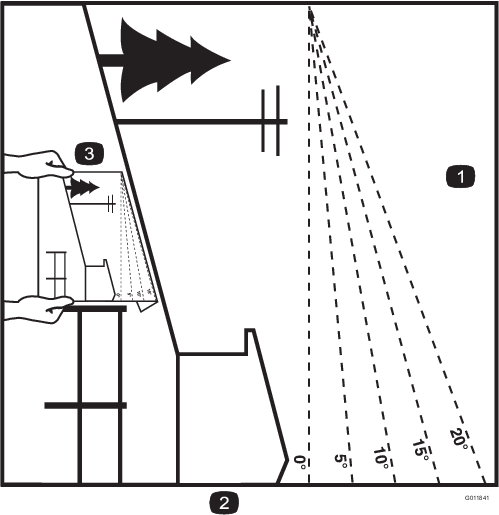
Safety and Instructional Decals
 |
Safety decals and instructions are easily visible to the operator and are located near any area of potential danger. Replace any decal that is damaged or lost. |







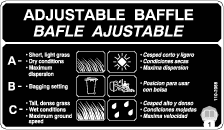


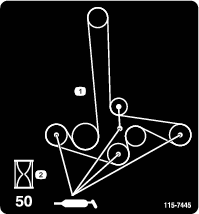
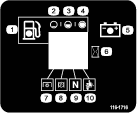
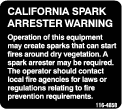
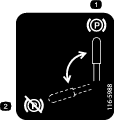


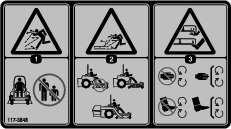
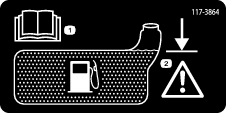
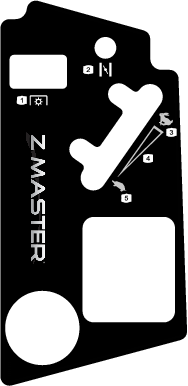

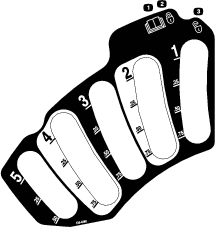
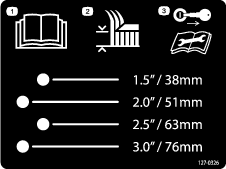



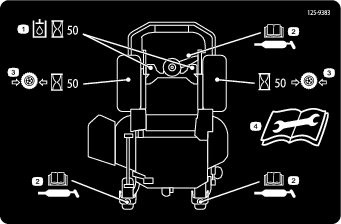
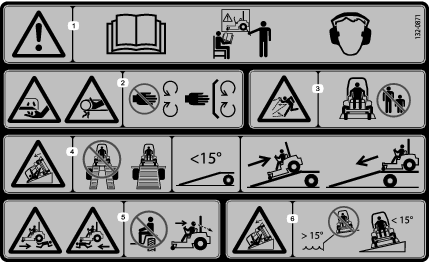
Product Overview
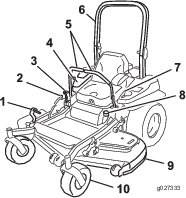
Become familiar with all the controls before you start the engine and operate the machine (Figure 4 and Figure 5).
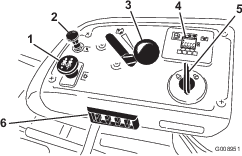
Hour Meter
The hour meter records the number of hours the engine has operated. It operates when the engine is running. Use these times for scheduling regular maintenance (Figure 6).
Fuel Gauge
The fuel gauge is located with the hour meter and the bars light up when the ignition switch is on (Figure 6).
The indicator light appears when the fuel level is low (approximately one gallon remaining in the fuel tank).
Safety-Interlock Indicators
There are symbols on the hour meter and the indicate with a black triangle that the interlock component is in the correct position (Figure 6).
Battery Indicator Light
If the ignition key is turned to the ON position for a few seconds, the battery voltage will be displayed in the area where the hours are normally displayed.
The battery light turns on when the ignition is turned on and when the charge is below the correct operating level (Figure 6).
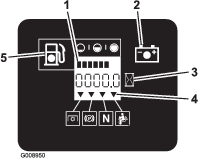
Throttle Control
The throttle control is variable between the FAST and SLOW positions.
You can move the throttle control between FAST and SLOW positions (Figure 7).
Always use the FAST position when turning on the mower deck with the blade-control switch (PTO).

Choke Knob
Blade-Control Switch (PTO)
Use the blade-control switch (PTO) is used to engage the electric clutch and drive the mower blades. Pull the switch up to engage the blades and release. To disengage the blades, push the blade-control switch (PTO) down or move a motion-control lever into the NEUTRAL-LOCK position.
-
Turn the ignition key to the START position (Figure 9).
Note: When the engine starts, release the key.
Important: Do not engage the starter for more than 5 seconds at a time. If the engine fails to start, wait 15 seconds between attempts. Failure to follow these instructions can burn out the starter motor.
Note: You may need multiple attempts to start the engine the first time after adding fuel to an empty fuel system.
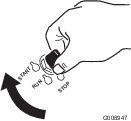
-
Turn the ignition key to the STOP position to stop the engine.
Ignition Switch
Use this switch to start the mower engine and has 3 positions: START, RUN, and OFF.
Motion-Control Levers
Use the motion-control levers to drive the machine forward, reverse, and turn either direction.
Fuel Shutoff Valve
The fuel-shutoff valve is located under the seat. Move the seat forward to access it.
Close the fuel shutoff valve when transporting, maintaining, or storing the machine.
Ensure that the fuel-shutoff valve is open when starting the engine.
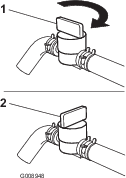
Attachments/Accessories
A selection of Toro approved attachments and accessories is available for use with the machine to enhance and expand its capabilities. Contact your Authorized Service Dealer or Distributor or go to www.Toro.com for a list of all approved attachments and accessories.
Note: Specifications and design are subject to change without notice.
Width
| 52-inch Deck | 72-inch Deck | |
|---|---|---|
| Without the deck | 119 cm (47 inches) | 150 cm (59 inches) |
| Deflector up | 135 cm (53 inches) | 187 cm (74 inches) |
| Deflector down | 172 cm (67 inches) | 222 cm (88 inches) |
| 52-inch Deck | 72-inch Deck | |
|---|---|---|
| Roll bar up | 202 cm (79 inches) | 219 cm (86 inches) |
| Roll bar down | 206 cm (81 inches) | 223 cm (88 inches) |
| 52-inch Deck | 72-inch Deck | |
|---|---|---|
| Roll bar up | 178 cm (70 inches) | 179 cm (71 inches) |
| Roll bar down | 118 cm (47 inches) | 119 cm (47 inches) |
| Model | Weight |
| 74955 | 495 kg (1,092 lb) |
| 74959 | 588 kg (1,296 lb) |
Operation
Note: Determine the left and right sides of the machine from the normal operating position.
Adding Fuel
-
For best results, use only clean, fresh (less than 30 days old), unleaded gasoline with an octane rating of 87 or higher ((R+M)/2 rating method).
-
Ethanol: Gasoline with up to 10% ethanol (gasohol) or 15% MTBE (methyl tertiary butyl ether) by volume is acceptable. Ethanol and MTBE are not the same. Gasoline with 15% ethanol (E15) by volume is not approved for use. Never use gasoline that contains more than 10% ethanol by volume, such as E15 (contains 15% ethanol), E20 (contains 20% ethanol), or E85 (contains up to 85% ethanol). Using unapproved gasoline may cause performance problems and/or engine damage which may not be covered under warranty.
-
Do not use gasoline containing methanol.
-
Do not store fuel either in the fuel tank or fuel containers over the winter unless you use a fuel stabilizer.
-
Do not add oil to gasoline.
Danger
In certain conditions, gasoline is extremely flammable and highly explosive. A fire or explosion from gasoline can burn you and others and can damage property.
-
Fill the fuel tank outdoors, in an open area, when the engine is cold. Wipe up any gasoline that spills.
-
Never fill the fuel tank inside an enclosed trailer.
-
Do not fill the fuel tank completely full. Add gasoline to the fuel tank until the level is 6 to 13 mm (1/4 to 1/2 inch) below the bottom of the filler neck. This empty space in the tank allows gasoline to expand.
-
Never smoke when handling gasoline, and stay away from an open flame or where gasoline fumes may be ignited by a spark.
-
Store gasoline in an approved container and keep it out of the reach of children. Never buy more than a 30-day supply of gasoline.
-
Do not operate the machine without the entire exhaust system in place and in proper working condition.
Danger
In certain conditions during fueling, static electricity can be released, causing a spark which can ignite the gasoline vapors. A fire or explosion from gasoline can burn you and others and can damage property.
-
Always place gasoline containers on the ground away from your vehicle before filling.
-
Do not fill gasoline containers inside a vehicle or on a truck or trailer bed, because interior carpets or plastic truck bed liners may insulate the container and slow the loss of any static charge.
-
When practical, remove gasoline-powered equipment from the truck or trailer and refuel the equipment with its wheels on the ground.
-
If this is not possible, then refuel such equipment on a truck or trailer from a portable container rather than from a gasoline-dispenser nozzle.
-
If you must use a gasoline-dispenser nozzle, keep the nozzle in contact with the rim of the fuel tank or container opening at all times until fueling is complete.
Warning
Gasoline is harmful or fatal if swallowed. Long-term exposure to vapors can cause serious injury and illness.
-
Avoid prolonged breathing of vapors.
-
Keep face away from nozzle and fuel tank or conditioner bottle opening.
-
Avoid contact with skin; wash off spills with soap and water.
Using Stabilizer/Conditioner
Use a fuel stabilizer/conditioner in the machine to provide the following benefits:
-
Keeps gasoline fresh during storage of 90 days or less. For longer storage it is recommended that the fuel tank be drained.
-
Cleans the engine while it runs
-
Eliminates gum-like varnish buildup in the fuel system, which causes hard starting
Important: Do not use fuel additives containing methanol or ethanol.
Add the correct amount of fuel stabilizer/conditioner to the fuel.
Note: A fuel stabilizer/conditioner is most effective when mixed with fresh gasoline. To minimize the chance of varnish deposits in the fuel system, use fuel stabilizer at all times.
Filling the Fuel Tank
-
Shut off the engine and set the parking brake.
-
Clean around fuel tank cap and remove the cap. Add unleaded regular gasoline to fuel tank, until the level is 6 to 13 mm (1/4 to 1/2 inch) below the bottom of the filler neck. This space in the tank allows gasoline to expand. Do not fill the fuel tank completely full.
-
Install fuel tank cap securely. Wipe up any spilled gasoline.
Checking the Engine-Oil Level
Before you start the engine and use the machine, check the oil level in the engine crankcase; refer to Checking the Engine-Oil Level.
Breaking in a New Machine
New engines take time to develop full power. Mower decks and drive systems have higher friction when new, placing additional load on the engine. Allow 40 to 50 hours of break-in time for new machines to develop full power and best performance.
Using the Rollover Protection System (ROPS)
Warning
Not using the ROPS system properly may result in severe injury or death.
-
Keep the roll bar in the fully raised locked position.
-
Ensure that the seat is secured to the machine.
-
Use the seat belt with the roll bar locked in the fully raised position.
Warning
You have no rollover protection when the roll bar is in the down position.
-
Lower the roll bar only when absolutely necessary.
-
Do not wear the seat belt when the roll bar is in the down position.
-
Drive slowly and carefully.
-
Raise the roll bar as soon as clearance permits.
-
Check carefully for overhead clearances (i.e., branches, doorways, electrical wires) before driving under any objects and do not contact them.
Lowering the Roll Bar
Raising the Roll Bar
-
To raise the roll bar, raise the roll bar to the operate position, rotate the knobs so that they move partially into the grooves (Figure 11).
-
Raise the roll bar to the full upright position while pushing on the upper roll bar and the pins will snap into position when the holes align with the pins (Figure 11).
-
Push the roll bar and ensure that both pins are engaged.
Think Safety First
Please read all safety instructions and symbols in the safety section. Knowing this information could help you or bystanders avoid injury.
Danger
Operating the machine on wet grass or steep slopes can cause sliding and loss of control.
-
Do not operate on slopes greater than 15 degrees.
-
Reduce speed and use extreme caution on slopes.
-
Do not operate the machine near water.
Danger
Wheels dropping over edges can cause rollovers, which may result in serious injury, death, or drowning.
Do not operate the machine near drop-offs.
Danger
Operating the machine while the roll bar is down may lead to serious injury or death in the event of a rollover.
Always keep the roll bar in the fully raised and locked position and use the seat belt.

Caution
This machine produces sound levels in excess of 85 dBA at the operator’s ear and can cause hearing loss through extended periods of exposure.
Wear hearing protection when operating this machine.

Operating the Parking Brake
Always set the parking brake when you stop the machine or leave it unattended.
Setting the Parking Brake
Warning
The parking brake may not hold the machine parked on a slope and could cause personal injury or property damage.
Do not park the machine on slopes unless the wheels are chocked or blocked.

Releasing the Parking Brake

Starting and Stopping the Engine
Starting the Engine
Important: Do not engage starter for more than 5 seconds at a time. If the engine fails to start, wait 15 seconds between attempts. Failure to follow these instructions can burn out the starter motor.
Note: You may need multiple attempts to start the engine the first time after adding fuel to an empty fuel system.
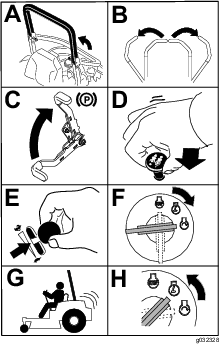
Stopping the Engine
Caution
Children or bystanders may be injured if they move or attempt to operate the machine while it is unattended.
Always remove the ignition key and set the parking brake when leaving the machine unattended, even if just for a few minutes.
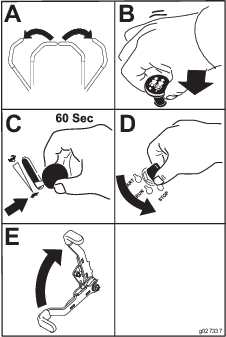
Important: Make sure that you close the fuel-shutoff valve before transporting or storing the machine, as fuel leakage may occur. Set the parking brake before transporting the machine. Make sure to remove the key as the fuel pump may run and cause the battery to lose charge.
Using the Safety-Interlock System
Caution
If the safety-interlock switches are disconnected or damaged, the machine could operate unexpectedly, causing personal injury.
-
Do not tamper with the interlock switches.
-
Check the operation of the interlock switches daily and replace any damaged switches before operating the machine.
Understanding the Safety-Interlock System
The safety-interlock system is designed to prevent the engine from starting unless the following occurs:
-
The parking brake is engaged.
-
The blade-control switch (PTO) is disengaged.
-
The motion-control levers are in the NEUTRAL-LOCK position
The safety-interlock system also is designed to shut off the engine when the traction controls are moved from the LOCKED position with the parking brake engaged or if you rise from the seat when the PTO is engaged.
The hour meter has symbols to notify the user when the interlock component is in the correct position. When the component is in the correct position, a triangle will light up in the corresponding square.

Testing the Safety-Interlock System
Test the safety-interlock system before you use the machine each time. If the safety system does not operate as described below, have an Authorized Service Dealer repair the safety system immediately.
-
Sit on the seat, engage the parking brake and move the blade-control switch (PTO) to the ON position. Try starting the engine; the engine should not start.
-
Sit on the seat, engage the parking brake and move the blade-control switch (PTO) to the OFF position. Move either motion-control lever (out of the NEUTRAL-LOCK position). Try starting the engine; the engine should not start. Repeat for other control lever.
-
Sit on the seat, engage the parking brake, move the blade-control switch (PTO) to the OFF position, and move the motion-control levers to the NEUTRAL-LOCK position. Start the engine. While the engine is running, release the parking brake, engage the blade-control switch (PTO), and rise slightly from the seat; the engine should shut off.
-
Sit on the seat, engage the parking brake, move the blade-control switch (PTO) to the OFF position, and move the motion-control levers to NEUTRAL-LOCK position. Start the engine. While the engine is running, center either motion-control lever and move it forward or reverse; the engine should shut off. Repeat this step for other motion-control lever.
-
Sit on the seat, disengage the parking brake, move the blade-control switch (PTO) to the OFF position, and move the motion-control levers to NEUTRAL-LOCK position. Try starting the engine; the engine should not start.
Driving the Machine Forward or Backward
The throttle control regulates the engine speed as measured in rpm (revolutions per minute). Place the throttle control in the FAST position for best performance. Always operate in the full throttle position when mowing.
Caution
Machine can spin very rapidly. You may lose control of machine and injure yourself or damage the machine.
-
Use caution when making turns.
-
Slow the machine down before making sharp turns.
Using the Motion-Control Levers
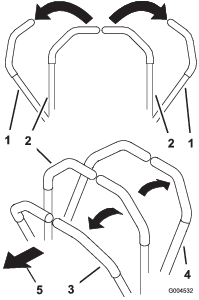
Driving Forward
Note: The engine shuts off when you move the traction control levers with the parking brake engaged.
To stop the machine , pull the motion-control levers to the NEUTRAL position.
-
Release the parking brake; refer to Releasing the Parking Brake.
-
Move the levers to the center, unlocked position.
-
To drive the machine forward, slowly push the motion-control levers forward (Figure 20).
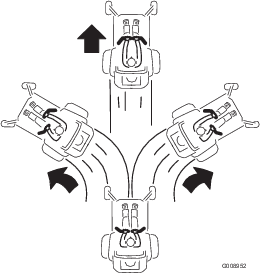
Driving Backward
-
Move the levers to the center, unlocked position.
-
To go backward, slowly pull the motion-control levers rearward (Figure 21).
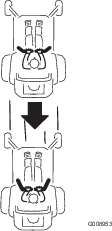
Stopping the Machine
To stop the machine, move the traction-control levers to neutral and then to the NEUTRAL-LOCK position, disengage the power takeoff (blade-control switch (PTO), and turn the ignition key to the OFF position.
Set the parking brake when you leave the machine; refer to Setting the Parking Brake. Remove the key from the ignition switch.
Caution
Children or bystanders may be injured if they move or attempt to operate the machine while it is unattended.
Always remove the ignition key and set the parking brake when leaving the machine unattended, even if just for a few minutes.
Adjusting the Height of Cut
Using the Transport Lock
The transport lock has 2 positions and is used with the deck-lift pedal. There is a LOCK position and a UNLOCK position for the transport position of the mower deck (Figure 22).
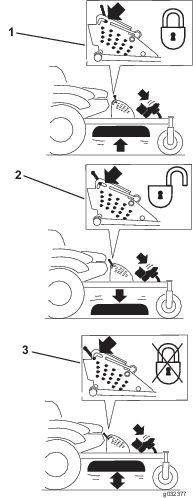
Adjusting the Height-of-Cut Pin
Adjust the height of cut from 25 to 140 mm (1 to 5-1/2 inches) in 6 mm (1/4 inch) increments by moving the clevis pin into different hole locations.
-
Move the transport lock to the LOCK position.
-
Push the deck-lift pedal with your foot and raise the mower deck to the TRANSPORT position (also the 140 mm (5-1/2 inch) cutting-height position) as shown in Figure 23.
-
To adjust, rotate the pin 90° and remove the pin from the height-of-cut bracket (Figure 23).
-
Select a hole in the height-of-cut bracket corresponding to the height-of-cut desired and insert the pin (Figure 23).
-
Push on the deck lift, pull back the transport lock, and slowly lower the mower deck.
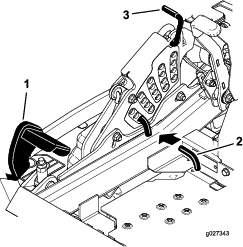
Adjusting the Anti-Scalp Rollers
Whenever you change the height-of-cut, adjust the height of the anti-scalp rollers.
-
Disengage the blade-control switch (PTO), move the motion-control levers to the NEUTRAL-LOCK position, and set the parking brake.
-
Shut off the engine, remove the key, and wait for all moving parts to stop before leaving the operating position.
-
Adjust the anti-scalp rollers as shown in Figure 24, Figure 25, and Figure 26.

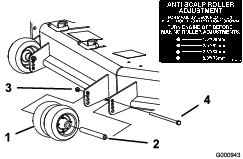

Adjusting the Flow-Baffle-Cam Locks
This procedure is applicable only to machines with the flow baffle locks. Certain models will have nuts and bolts in place of the flow baffle locks and you can adjust them the same.
You can adjust the mower discharge flow for different types of mowing conditions. Position the cam locks and baffle to give the best quality of cut.
-
Disengage the blade-control switch (PTO), move the motion- control levers to the NEUTRAL-LOCK position, and set the parking brake.
-
Shut off the engine, remove the key, and wait for all moving parts to stop before leaving the operating position.
-
To adjust the cam locks, swing the lever up to loosen the cam lock (Figure 27).
-
Adjust the baffle and cam locks in the slots to the desired discharge flow.
-
Swing the lever back over to tighten the baffle and cam locks (Figure 27).
-
If the cam locks do not lock the baffle into place or it is too tight, loosen the lever and then rotate the cam lock. Adjust the cam lock until you obtain the desired locking pressure.

Positioning the Flow Baffle
The following figures are only recommendations for use. Adjustments will vary by grass type, moisture content, and height of grass.
Note: If the engine power draws down and the mower ground speed is the same, open up the baffle.
Position A
This is the full rear position. The suggested use for this position is a follows:
-
Use for short, light grass mowing conditions
-
Use in dry conditions
-
For smaller grass clippings
-
Propels grass clippings farther away from the mower
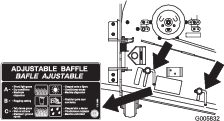
Position B
Use this position when bagging. Always align it with the blower opening.
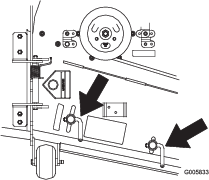
Position C
This is the full open position. The suggested use for this position is as follows:
-
Use in tall, dense grass mowing conditions
-
Use in wet conditions
-
Lowers the engine power consumption
-
Allows increased ground speed in heavy conditions
-
This position is similar to the benefits of the Toro SFS mower.
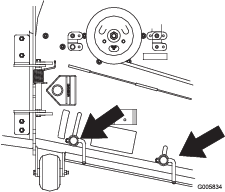
Positioning the Seat
The seat can move forward and backward. Position the seat where you have the best control of the machine and are most comfortable.
To adjust the seat, move the lever sideways to unlock the seat (Figure 31).
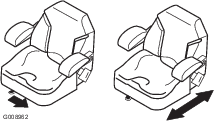
Using the Drive-Wheel-Release Valves
Warning
Hands may become entangled in the rotating drive components below the engine deck, which could result in serious injury.
Shut off the engine, remove the key, and allow all moving parts to stop before accessing the drive-wheel-release valves.
Warning
The engine and hydraulic drive units can become very hot. Touching a hot engine or hydraulic drive units can cause severe burns.
Allow the engine and hydraulic drive units to cool completely before accessing the drive-wheel-release valves.
The drive-wheel-release valves are located in the back of each hydraulic-drive unit, under the seat.
Note: Make sure that the release valves are in the fully horizontal position when operating the machine; otherwise, severe damage to the hydraulic system can occur.
-
Disengage the PTO (blade-control switch) and turn the ignition key to off. Move the levers to NEUTRAL-LOCK position and apply parking brake. Remove the key.
-
Rotate the release-valve levers vertically to push the machine. This allows hydraulic fluid to bypass the pump, enabling the wheels to turn (Figure 32).
-
Disengage the parking brake before pushing the machine.
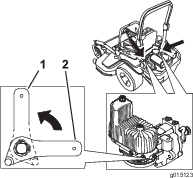
-
Rotate the release valve levers horizontally to run the machine (Figure 32).
Using the Side Discharge
The mower has a hinged grass deflector that disperses clippings to the side and down toward the turf.
Danger
Without a grass deflector, discharge cover, or complete grass catcher assembly mounted in place, you and others are exposed to blade contact and thrown debris. Contact with rotating mower blade(s) and thrown debris will cause injury or death.
-
Never remove the grass deflector from the mower because the grass deflector routes material down toward the turf. If the grass deflector is ever damaged, replace it immediately.
-
Never put your hands or feet under the mower.
-
Never try to clear the discharge area or mower blades unless you move the power takeoff (blade-control switch (PTO) to the OFF position, rotate the ignition key to off and remove the key.
-
Make sure that the grass deflector is in the down position.
Transporting the Machine
Use a heavy-duty trailer or truck to transport the machine. Ensure that the trailer or truck has all necessary brakes, lighting, and marking as required by law. Please carefully read all the safety instructions. Knowing this information could help you, your family, pets, or bystanders avoid injury.
Warning
Driving on the street or roadway without turn signals, lights, reflective markings, or a slow-moving vehicle emblem is dangerous and can lead to accidents, causing personal injury.
Do not drive machine on a public street or roadway.
-
If you are using a trailer, connect it to the towing vehicle and connect the safety chains.
-
If applicable, connect the trailer brakes.
-
Load the machine onto the trailer or truck.
-
Shut off the engine, remove the key, set the brake, and close the fuel valve.
-
Use the tie-down loops on the machine to securely fasten the machine to the trailer or truck with straps, chains, cable, or ropes (Figure 33).
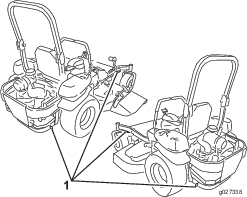
Loading the Machine
Use extreme caution when loading or unloading the machine onto a trailer or a truck. Use a full-width ramp that is wider than the machine for this procedure. Back the machine up the ramp and drive it forward down the ramp (Figure 34).

Important: Do not use narrow individual ramps for each side of the machine.
Ensure that the ramp is long enough so that the angle with the ground does not exceed 15 degrees (Figure 35). On flat ground, this requires a ramp to be at least 4 times as long as the height of the trailer or truck bed to the ground. A steeper angle may cause mower components to get caught as the machine moves from the ramp to the trailer or truck. Steeper angles may also cause the machine to tip or lose control. If you are loading the machine on or near a slope, position the trailer or truck so that it is on the down side of the slope and the ramp extends up the slope. This will minimize the ramp angle.
Warning
Loading a machine onto a trailer or truck increases the possibility of a tip-over and could cause serious injury or death.
-
Use extreme caution when operating a machine on a ramp.
-
Ensure that the ROPS is in the up position and use the seat belt when loading or unloading the machine. Ensure that the ROPS will clear the top of an enclosed trailer.
-
Use only a full-width ramp; do not use individual ramps for each side of the machine.
-
Do not exceed a 15-degree angle between the ramp and the ground or between the ramp and the trailer or truck.
-
Ensure the length of ramp is at least 4 times as long as the height of the trailer or truck bed to the ground. This ensures that ramp angle does not exceed 15 degrees on flat ground.
-
Back the machine up the ramp and drive it forward down the ramp.
-
Avoid sudden acceleration or deceleration while driving the machine on a ramp, as this could cause a loss of control or a tip-over situation.
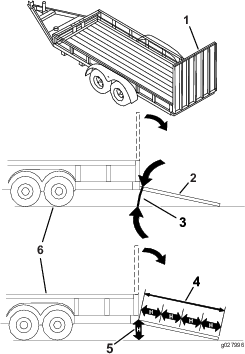
Operating Tips
Maximize Cutting Efficiency
For best mowing and maximum air circulation, operate the engine at the fast throttle position. Air is required to thoroughly cut grass clippings, so do not set the height of cut so low as to totally surround the mower in uncut grass. Always try to have 1 side of the mower free from uncut grass, which allows air to be drawn into the mower.
Cutting a Lawn for the First Time
Cut the grass slightly longer than normal to ensure the cutting height of the mower does not scalp any uneven ground. However, the cutting height used in the past is generally the best to use. When cutting grass longer than 15 cm (6 inches) tall, you may want to cut the lawn twice to ensure an acceptable quality of cut.
Cut a Third of the Grass Blade
It is best to cut only about 1/3 of the grass blade. Cutting more than that is not recommended unless grass is sparse, or it is late fall when grass grows more slowly.
Alternate the Mowing Direction
Alternate the mowing direction to keep the grass standing straight. This also helps disperse clippings, which enhances decomposition and fertilization.
Mow at the Correct Intervals
Grass grows at different rates at different times. So to maintain the same cutting height, mow more often in early spring. As the grass growth rate slows in midsummer, mow less frequently. If you cannot mow for an extended period, first mow at a high cutting height; then mow again 2 days later at a lower height setting.
Choose the Best Speed
To improve cut quality, use a slower ground speed in certain conditions.
Avoid Cutting Too Low
If the cutting width of the mower is wider than the mower you previously used, raise the cutting height to ensure that uneven turf is not cut too short.
Cutting Long Grass
If the grass is ever allowed to grow slightly longer than normal, or if it contains a high degree of moisture, raise the cutting height higher than usual and cut the grass at this setting. Then cut the grass again using the lower, normal setting.
Stopping the Machine
If you must stop the forward motion of the machine while mowing, a clump of grass clippings may drop onto the lawn. To avoid this, move onto a previously cut area with the blades engaged.
Keep the Underside of the Mower Clean
Clean clippings and dirt from the underside of the mower after each use. If grass and dirt build up inside the mower, the cutting quality eventually becomes unsatisfactory.
Maintaining the Blade
Maintain a sharp blade throughout the cutting season, because a sharp blade cuts cleanly without tearing or shredding the grass blades. Tearing and shredding turns grass brown at the edges, which slows growth and increases the chance of disease. Check the cutter blades daily for sharpness and for any wear or damage. File down any nicks and sharpen the blades as necessary. If a blade is damaged or worn, replace it immediately with a genuine Toro replacement blade.
Maintenance
Recommended Maintenance Schedule(s)
| Maintenance Service Interval | Maintenance Procedure |
|---|---|
| After the first 8 hours |
|
| After the first 100 hours |
|
| After the first 250 hours |
|
| Before each use or daily |
|
| Every 50 hours |
|
| Every 100 hours |
|
| Every 150 hours |
|
| Every 200 hours |
|
| Every 250 hours |
|
| Every 300 hours |
|
| Every 500 hours |
|
| Every 600 hours |
|
| Monthly |
|
| Yearly |
|
| Yearly or before storage |
|
Important: Refer to your engine operator's manual for additional maintenance procedures.
Caution
If you leave the key in the ignition switch, someone could accidently start the engine and seriously injure you or other bystanders.
Remove the key from the ignition before you do any maintenance.
Lubrication
Grease more frequently when operating conditions are extremely dusty or sandy.
Grease Type: No. 2 lithium or molybdenum grease
-
Disengage the blade-control switch (PTO), move the motion-control levers to the NEUTRAL-LOCK position and set the parking brake.
-
Shut off the engine, remove the key, and wait for all moving parts to stop before leaving the operating position.
-
Clean the grease fittings with a rag. Make sure to scrape any paint off the front of the fitting(s).
-
Connect a grease gun to the fitting. Pump grease into the fittings until grease begins to ooze out of the bearings.
-
Wipe up any excess grease.
Adding Light Oil or Spray Lubrication
| Maintenance Service Interval | Maintenance Procedure |
|---|---|
| Every 100 hours |
|
Lubricate the deck-lift pivots.
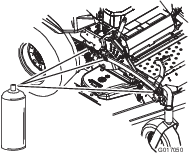
Greasing the Mower
| Maintenance Service Interval | Maintenance Procedure |
|---|---|
| Every 50 hours |
|
| Yearly |
|
Important: Make sure that the cutting unit spindles are full of grease weekly.
-
Disengage the blade-control switch (PTO), move the motion-control levers to the NEUTRAL-LOCK position, and set the parking brake.
-
Shut off the engine, remove the key, and wait for all moving parts to stop before leaving the operating position.
-
Grease the mower deck idler pulley pivot until grease comes out the bottom (Figure 37).
-
Grease the 3 spindle bearings until grease comes out the lower seals (Figure 37).
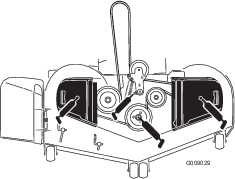
-
Grease the drive belt idler arm (Figure 37).
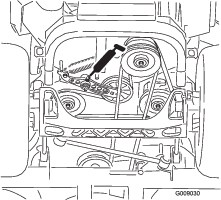
-
Remove the dust cap and adjust the caster pivots.
Note: Keep the dust cap off until greasing is complete. Refer to Adjusting the Caster-Pivot Bearing.
-
Remove the hex plug and thread a grease fitting into the hole.
-
Pump grease into the fitting until it oozes out around the top bearing.
-
Remove the grease fitting from the hole.
-
Install the hex plug and dust cap (Figure 39).

Lubricating the Caster-Wheel Hubs
| Maintenance Service Interval | Maintenance Procedure |
|---|---|
| Yearly |
|
-
Shut off the engine, wait for all moving parts to stop, and remove the key. Engage the parking brake.
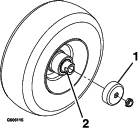
-
Raise the front of the machine up and support it with jack stands.
-
Remove the caster wheel from the caster forks.
-
Remove the seal guards from the wheel hub.
-
Remove 1 of the spacer nuts from the axle assembly in the caster wheel.
Note: Note that thread-locking adhesive has been applied to lock the spacer nuts to the axle. Remove the axle (with the other spacer nut still assembled to it) from the wheel assembly.
-
Pry out the seals and inspect the bearings for wear or damage and replace them if necessary.
-
Pack the bearings with a general-purpose grease.
-
Insert 1 bearing and 1 new seal into the wheel.
Note: Replace the seals.
-
If the axle assembly has had both spacer nuts removed (or broken loose), apply a thread locking adhesive to 1 spacer nut and thread it onto the axle with the wrench flats facing outward.
Note: Do not thread the spacer nut all the way onto the end of the axle. Leave approximately 3 mm (1/8 inch) from the outer surface of the spacer nut to the end of the axle inside the nut.
-
Insert the assembled nut and axle into the wheel on the side of the wheel with the new seal and bearing.
-
With the open end of the wheel facing up, fill the area inside the wheel around the axle full of general-purpose grease.
-
Insert the second bearing and new seal into the wheel.
-
Apply a thread-locking adhesive to the second spacer nut and thread it onto the axle with the wrench flats facing outward.
-
Torque the nut to 8 to 9 N∙m (75 to 80 in-lb), loosen, then torque it again to 2 to 3 N∙m (20 to 25 in-lb).
Note: Make sure that the axle does not extend beyond either nut.
-
Install the seal guards over the wheel hub and insert the wheel into the caster fork. Install the caster bolt and tighten the nut fully.
Important: To prevent seal and bearing damage, check the bearing adjustment often. Spin the caster tire. The tire should not spin freely (more than 1 or 2 revolutions) or have any side play. If the wheel spins freely, adjust the torque on the spacer nut until there is a slight amount of drag. Apply thread locking adhesive.
Engine Maintenance
Servicing the Air Cleaner
| Maintenance Service Interval | Maintenance Procedure |
|---|---|
| Every 150 hours |
|
| Every 300 hours |
|
| Every 600 hours |
|
Note: Check the filters more frequently if the operating conditions are extremely dusty or sandy.
Removing the Filters
-
Disengage the PTO, move the motion-control levers to the NEUTRAL-LOCK position, and set the parking brake.
-
Shut off the engine, remove the key, and wait for all moving parts to stop before leaving the operating position.
-
Release the latches on the air cleaner and pull the air-inlet cover off the air-cleaner body (Figure 41).
-
Clean the air-inlet screen and cover.
-
Install the air-inlet cover and secure it with the latches (Figure 41).
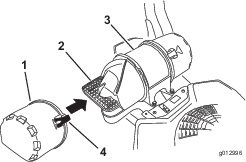
-
Release the latches on the air cleaner and pull the air-cleaner cover off the air-cleaner body (Figure 42).
-
Clean the inside of the air-cleaner cover with compressed air.
-
Gently slide the primary filter out of the air-cleaner body (Figure 42).
Note: Avoid knocking the filter into the side of the body.
-
Remove the inner filter only if you intend to replace it.
Important: Never attempt to clean the inner filter. If the safety filter is dirty, then the primary filter is damaged. Replace both filters.
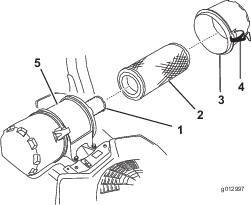
-
Inspect the primary filter for damage by looking into the filter, while shining a bright light on the outside of the filter.
Note: Holes in the filter will appear as bright spots. If the filter is damaged, discard it.
Servicing the Primary Filter
-
If the primary filter is dirty, bent, or damaged, replace it.
-
Do not clean the primary filter.
Servicing the Safety Filter
Replace the safety filter, never clean it.
Important: Do not attempt to clean the safety filter. If the safety filter is dirty, then the primary filter is damaged. Replace both filters.
Installing the Filters
Important: To prevent engine damage, always operate the engine with both air filters and the cover installed.
-
If installing new filters, check each filter for shipping damage.
Note: Do not use a damaged filter.
-
If the inner filter is being replaced, carefully slide it into the filter body (Figure 42).
-
Carefully slide the primary filter over the inner filter (Figure 42).
Note: Ensure that the primary filter is fully seated by pushing on the outer rim while installing it.
Important: Do not press on the soft, inside area of the filter.
-
Install the air-cleaner cover and secure the latches (Figure 42).
Servicing the Engine Oil
Oil Type: Detergent oil (API service SJ or higher)
Oil Capacity: with a filter change—1.65 L (56 oz); without a filter change—1.50 L (51 oz)
Viscosity: See the table below.
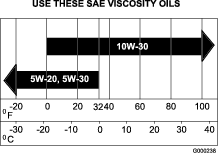
Note: Use of synthetic oil having 5W-20 or 5W-30 rating is acceptable, up to 4°C (40°F).
Note: Synthetic oils provide better starting in extreme cold below -23°C (-10°F).
Checking the Engine-Oil Level
| Maintenance Service Interval | Maintenance Procedure |
|---|---|
| Before each use or daily |
|
Note: Check the oil when the engine is cold.
Warning
Contact with hot surfaces may cause personal injury.
Keep hands, feet, face, clothing, and other body parts away from the muffler and other hot surfaces.
Important: Do not overfill the crankcase with oil because damage to the engine may result. Do not run engine with oil below the Low mark because the engine may be damaged.
-
Disengage the PTO, move the motion-control levers to the NEUTRAL-LOCK position, and set the parking brake.
-
Shut off the engine, remove the key, and wait for all moving parts to stop before leaving the operating position (Figure 44).

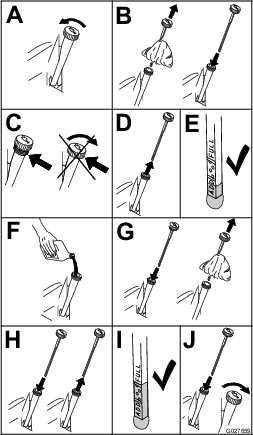
Changing the Engine Oil
| Maintenance Service Interval | Maintenance Procedure |
|---|---|
| After the first 8 hours |
|
| Every 100 hours |
|
Note: Dispose of the used oil at a recycling center.
-
Start the engine and let it run for 5 minutes.
Note: This warms the oil so that it drains better.
-
Park the machine so that the rear is slightly lower than the front to ensure that the oil drains completely.
-
Disengage the PTO, move the motion-control levers to the NEUTRAL-LOCK position, and set the parking brake.
-
Shut off the engine, remove the key, and wait for all moving parts to stop before leaving the operating position (Figure 45).

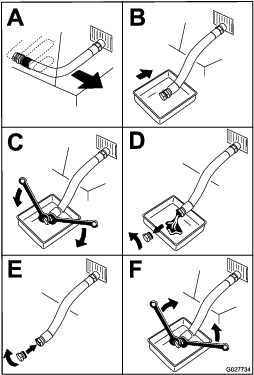
-
Slowly pour approximately 80% of the specified oil into the filler tube and slowly add the additional oil to bring it to the Full mark (Figure 46).
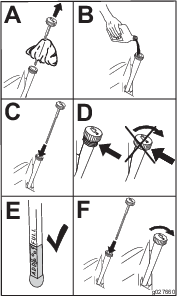
-
Start the engine and drive to a flat area.
-
Check the oil level again.
Changing the Engine-Oil Filter
| Maintenance Service Interval | Maintenance Procedure |
|---|---|
| Every 200 hours |
|
Note: Change the engine-oil filter more frequently when operating conditions are extremely dusty or sandy.
-
Drain the oil from the engine; refer to Changing the Engine Oil.
-
Change the engine-oil filter (Figure 47).


Note: Ensure the oil-filter gasket touches the engine, and then turn the oil filter an extra 3/4 turn.
-
Fill the crankcase with the proper type of new oil; refer to Changing the Engine Oil.
Servicing the Spark Plug
| Maintenance Service Interval | Maintenance Procedure |
|---|---|
| Every 200 hours |
|
Ensure that the air gap between the center and side electrodes is correct before installing the spark plug. Use a spark plug wrench for removing and installing the spark plug(s) and a gapping tool/feeler gauge to check and adjust the air gap. Install a new spark plug(s) if necessary.
Type : Champion® XC12YC, or equivalent
Air Gap: 0.76 mm (0.030 inch)
Removing the Spark Plug
-
Shut off the engine, remove the key, and wait for all moving parts to stop before leaving the operating position.
-
Disengage the PTO, move the motion-control levers to the NEUTRAL-LOCK position and set the parking brake.
-
Remove the left hydraulic-unit shroud in the order listed with Figure 48. This gives you access to the front spark plug.

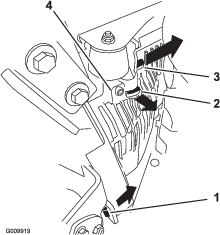
-
Remove the spark plug.

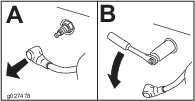
-
Install the left hydraulic-unit shroud (Figure 48).
Checking the Spark Plug
Important: Replace the spark plug(s) when it has: a black coating, worn electrodes, an oily film, cracks or reuse is questionable.
If you see light brown or gray on the insulator, the engine is operating properly. A black coating on the insulator usually means that the air cleaner is dirty.
Set the gap to 0.76 mm (0.030 inches).
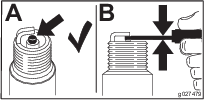
Installing the Spark Plug
Tighten the spark plug(s) to 24.4 to 29.8 N-m (18 to 22 ft-lb).
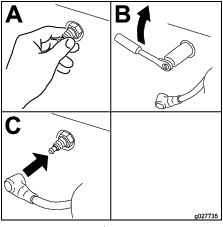
Checking the Spark Arrester
| Maintenance Service Interval | Maintenance Procedure |
|---|---|
| Every 50 hours |
|
Warning
Hot exhaust system components may ignite gasoline vapors even after you shut off the engine. Hot particles exhausted during engine operation may ignite flammable materials. Fire may result in personal injury or property damage.
Do not refuel or run the engine unless the spark arrester is installed.
-
Shut off the engine, wait for all moving parts to stop, and remove the key. Engage the parking brake.
-
Wait for the machine to cool.
-
If there are any breaks in the screen or welds, replace the arrester.
-
If the screen is plugged, remove the arrester and shake the loose any particles out of the arrester and clean the screen with a wire brush (soak it in solvent if necessary). Install the arrester on an exhaust outlet.
Fuel System Maintenance
Replacing the Fuel Filter
| Maintenance Service Interval | Maintenance Procedure |
|---|---|
| Every 500 hours |
|
The fuel filter is located near the engine on the front or rear side of the engine.
-
Disengage the PTO, move the motion-control levers to the NEUTRAL-LOCK position, and set the parking brake.
-
Shut off the engine, remove the key, and wait for all moving parts to stop before leaving the operating position.
-
Allow the machine to cool down.
-
Close the fuel-shutoff valve under the seat (Figure 52).
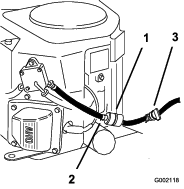
-
Squeeze the ends of the hose clamps together and slide them away from the filter (Figure 52).
-
Remove the filter from the fuel lines.
-
Install a new filter and move the hose clamps close to the filter (Figure 52).
-
Open the fuel-shutoff valve.
Important: Install the fuel-line hoses and secure with plastic ties the same as they were originally installed at the factory to keep the fuel line away from components that can damage the fuel line.
Servicing the Fuel Tank
Do not attempt to drain the fuel tank. Ensure that an Authorized Service Dealer drains the fuel tank and services any components of the fuel system.
Electrical System Maintenance
Servicing the Battery
| Maintenance Service Interval | Maintenance Procedure |
|---|---|
| Monthly |
|
Warning
CALIFORNIA
Proposition 65 Warning
Use of this product may cause exposure to chemicals known to the State of California to cause cancer, birth defects, or other reproductive harm.
Danger
Battery electrolyte contains sulfuric acid, which is a deadly poison and causes severe burns.
Do not drink electrolyte and avoid contact with skin, eyes, or clothing. Wear eye protection to shield your eyes and rubber gloves to protect your hands.
Removing the Battery
Warning
Battery terminals or metal tools could short against metal machine components causing sparks. Sparks can cause the battery gasses to explode, resulting in personal injury.
-
When removing or installing the battery, do not allow the battery terminals to touch any metal parts of the machine.
-
Do not allow metal tools to short between the battery terminals and metal parts of the machine.
Warning
Incorrect battery cable routing could damage the machine and cables causing sparks. Sparks can cause the battery gasses to explode, resulting in personal injury.
-
Always disconnect the negative (black) battery cable before disconnecting the positive (red) cable.
-
Always connect the positive (red) battery cable before connecting the negative (black) cable.
-
Disengage the blade-control switch (PTO), move the motion-control levers to the NEUTRAL-LOCK position and set the parking brake.
-
Shut off the engine, remove the key, and wait for all moving parts to stop before leaving the operating position.
-
Remove the battery as shown in Figure 53.

Installing the Battery
Note: Position battery in the tray with the terminal posts opposite from the hydraulic tank (Figure 53).
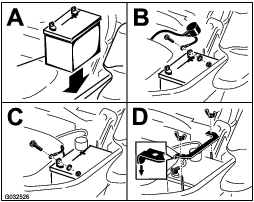
Charging the Battery
Warning
Charging the battery produces gasses that can explode.
Never smoke near the battery and keep sparks and flames away from battery.
Important: Always keep the battery fully charged (1.265 specific gravity). This is especially important to prevent battery damage when the temperature is below 0°C (32°F).
-
Charge battery for 10 to 15 minutes at 25 to 30 A or 30 minutes at 10 A.
-
When the battery is fully charged, unplug the charger from the electrical outlet, then disconnect the charger leads from the battery posts (Figure 55).
-
Install the battery in the machine and connect the battery cables; refer to Installing the Battery.
Note: Do not run the machine with the battery disconnected; electrical damage may occur.
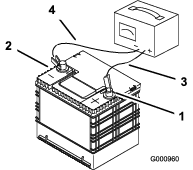
Servicing the Fuses
The electrical system is protected by fuses. However, it requires no maintenance. If a fuse blows, check the component and circuit for a malfunction or short.
The fuses are located on right console next to the seat (Figure 56).
-
To replace the fuses, pull out the fuse to remove it.
-
Install a new fuse (Figure 56).
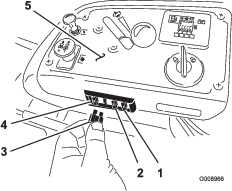
Drive System Maintenance
Checking the Seat Belt
| Maintenance Service Interval | Maintenance Procedure |
|---|---|
| Before each use or daily |
|
Inspect the seat belt for wear, cuts, and proper operation of retractor and buckle. Replace the seat belt if it is damaged.
Checking the Rollover Protection System (ROPS) Knobs
| Maintenance Service Interval | Maintenance Procedure |
|---|---|
| Before each use or daily |
|
Warning
To avoid injury or death from rollover, keep the roll bar in the fully raised locked position and use the seat belt.
Ensure that the seat is secured to the machine.
Check that both the mounting hardware and the knobs are in good working condition. Make sure that the knobs are fully engaged with the ROPS in the raised position. You may need to push the upper hoop of the roll bar forward or pull it rearward to fully engage both knobs.
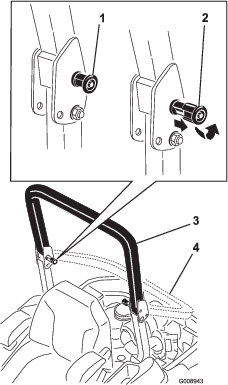
Adjusting the Tracking
-
Disengage the blade-control switch (PTO).
-
Drive to an open flat area, move the motion-control levers to the NEUTRAL-LOCK position.
-
Move the throttle midway between fast and slow.
-
Move both motion-control levers all the way forward until they both hit the stops in the T-slot.
-
Check which way the machine tracks.
-
If it tracks to the right, loosen the bolts and adjust the left stop plate rearward on the left T-slot until the machine tracks straight (Figure 58).
-
If it tracks to the left, loosen the bolts and adjust the right stop plate rearward on the right T-slot until the machine tracks straight (Figure 58).
-
-
Tighten the stop plate (Figure 58).
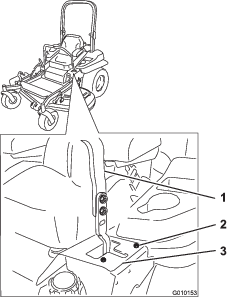
Checking the Tire Pressure
| Maintenance Service Interval | Maintenance Procedure |
|---|---|
| Every 50 hours |
|
Maintain the air pressure in the front and rear tires at 90 kPa (13 psi). Uneven tire pressure can cause an uneven cut. Check the tires when they are cold to get the most accurate pressure reading.

Checking the Wheel Lug Nuts
| Maintenance Service Interval | Maintenance Procedure |
|---|---|
| After the first 100 hours |
|
| Every 500 hours |
|
Check and torque the wheel lug nuts to 122-129 N∙m (90-95 ft-lb).
Checking the Wheel Hub Slotted Nut
| Maintenance Service Interval | Maintenance Procedure |
|---|---|
| After the first 100 hours |
|
| Every 500 hours |
|
Check and ensure that the torque of the slotted nut is 286 to 352 N∙m (211 to 260 ft-lb).
Note: Do not use anti-seize on the wheel hub.
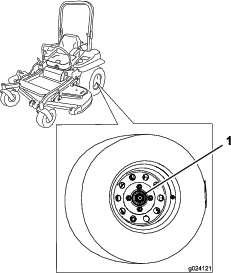
Adjusting the Caster-Pivot Bearing
| Maintenance Service Interval | Maintenance Procedure |
|---|---|
| Every 500 hours |
|
-
Disengage the blade-control switch (PTO), move the motion-control levers to the NEUTRAL-LOCK position, and set the parking brake.
-
Shut off the engine, remove the key, and wait for all moving parts to stop before leaving the operating position.
-
Remove the dust cap from the caster (Figure 61).
-
Tighten the locknut until the spring washers are flat and then back off a 1/4 turn to properly set the pre-load on the bearings (Figure 61).
Important: Make sure that the spring washers are installed correctly as shown in Figure 61.
-
Install the dust cap (Figure 61).
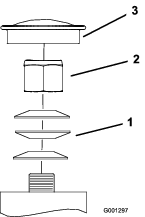
Using the Clutch Shim
Some machines have clutches that contain a brake shim. When the clutch brake has worn to the point where the clutch no longer engages consistently, you can remove the shim to extend the clutch life.
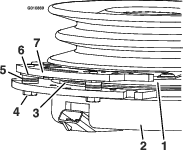
Removing the Clutch Shim
-
Shut off the engine, wait for all moving parts to stop, and remove the key.
-
Engage the parking brake and allow the machine to cool completely.
-
Using an air compressor, blow out any debris from under the brake pole and around the brake spacers.
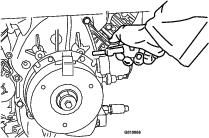
-
Check the condition of the wire harness leads, connectors, and terminals. Clean or repair them as necessary.
-
Verify that 12 V is present at the clutch connector when you engage the PTO switch.
-
Measure the gap between the rotor and armature. If the gap is greater than 1 mm (0.04 inch), proceed with the following steps:
-
Loosen both brake mounting bolts a half to a full turn as shown below.
Note: Do not remove the brake pole from the field shell/armature. The brake pole has worn to match the armature and needs to continue to match after you remove the shim to ensure the proper brake torque.
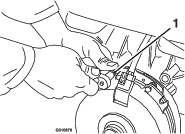
-
Use a needle nose pliers or your hand to take hold of the tab and remove the shim. Do not discard the shim until you have confirmed the proper clutch function.
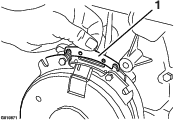
-
Using a pneumatic line, blow out any debris from under the brake pole and around the brake spacers.
-
Torque each bolt (M6 x 1) to 12.3 to 13.7 N∙m (0.5 to 10.5 ft-lb).
-
Using a 0.010 inch thick feeler gauge, verify that there is a gap between the rotor and armature face on both sides of the brake pole as shown in Figure 66 and Figure 67.
Note: Because of the way that the rotor and armature faces wear (peaks and valleys), it may be difficult to measure the true gap.


-
If the gap is less than 0.010 inch, install the shim and reference the section.
-
If the gap is sufficient, proceed to the safety check in step 6.
-
-
Perform the following safety check:
-
Sit on the seat and start the engine.
-
Make sure that the blades do not engage with the PTO switch off and the clutch disengaged.
If the clutch does not disengage, install the shim; refer to .
-
Engage and disengage the PTO switch 10 consecutive times to ensure that the clutch is functioning properly. If the clutch does not engage properly, refer to.
-
-
Cooling System Maintenance
Cleaning the Engine Screen and Engine-Oil Cooler
| Maintenance Service Interval | Maintenance Procedure |
|---|---|
| Before each use or daily |
|
Remove any buildup of grass, dirt, or other debris from the oil cooler (Figure 68).


Remove any buildup of grass, dirt, or other debris from the engine screen. This helps ensure adequate cooling and correct engine speed and reduces the possibility of overheating and mechanical damage to the engine (Figure 69).
Cleaning the Engine-Cooling Fins and Shrouds
| Maintenance Service Interval | Maintenance Procedure |
|---|---|
| Every 100 hours |
|
-
Disengage the PTO and set the parking brake.
-
Shut off the engine, remove the key, and wait for all moving parts to stop before leaving the operating position.
-
Remove the air intake screen, recoil starter, and fan housing (Figure 69).
-
Clean the debris and grass from the engine parts.
-
Install air intake screen, recoil starter, and fan housing (Figure 69).
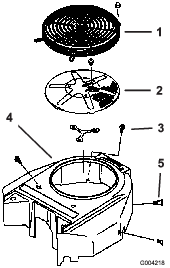
Check and Clean the Hydraulic Units
| Maintenance Service Interval | Maintenance Procedure |
|---|---|
| Before each use or daily |
|
-
Disengage the PTO and set the parking brake.
-
Shut off the engine, remove the key, and wait for all moving parts to stop before leaving the operating position.
-
Move the seat forward.
-
Clean the debris and grass from the hydraulic units (Figure 70).
-
Position the seat.

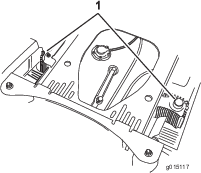
Brake Maintenance
Adjusting the Parking Brake
| Maintenance Service Interval | Maintenance Procedure |
|---|---|
| After the first 100 hours |
|
| Every 500 hours |
|
Note: Perform this procedure also when a brake component has been removed or replaced.
-
Move the machine onto a level surface.
-
Disengage the blade-control switch (PTO), move the motion-control levers to the NEUTRAL-LOCK position and engage the parking brake.
-
Shut off the engine, wait for all moving parts to stop, and remove the key.
-
Raise the back of the machine up and support the machine with jack stands.
Danger
Mechanical or hydraulic jacks may fail to support the machine and cause a serious injury.
-
Use jack stands when supporting the machine.
-
Do not use hydraulic jacks.
-
-
Remove the rear tires from the machine.
-
Remove any debris from the brake area.
-
Rotate the drive-wheel-release handle to the released position. Refer to Using the Drive-Wheel-Release Valves.
-
Check to see if there is a visible gap between the L-bracket and the linkage stop (Figure 71).

-
Disengage the parking brake, the lever should be in the down position.
-
Turn the wheel hub by hand in both directions relative to the caliper; the wheel hub should move freely between the caliper.
-
If a gap is needed or the wheel hub does not move freely, do the following:
-
Disengage the parking brake.
-
Disconnect and fine-tune the rear linkage assembly:
-
Shorten the link to create a gap.
-
Lengthen the link to allow wheel hub movement.
-
-
Reconnect the rear linkage assembly.
-
-
Engage the parking brake and check the gap.
-
Repeat steps 9 through 13 until a visible gap is achieved and the wheel hub rotates freely.
-
Repeat this procedure for the brake on the opposite side.
-
Rotate the drive-wheel release handle to the operating position. Refer toUsing the Drive-Wheel-Release Valves.
-
Install the rear tires and torque the lug nuts. Refer to Checking the Wheel Lug Nuts.
-
Remove the jack stands.
Belt Maintenance
Inspecting the Belts
| Maintenance Service Interval | Maintenance Procedure |
|---|---|
| Every 50 hours |
|
Check the belts for squealing when the belt is rotating; blades slipping when cutting grass; frayed belt edges; burn marks; and cracks, which are signs of a worn mower belt. Replace the mower belt if any of these conditions occur.
Replacing the Mower Belt
-
Disengage the PTO, move the motion-control levers to the NEUTRAL-LOCK position, and set the parking brake.
-
Shut off the engine, remove the key, and wait for all moving parts to stop before leaving the operating position.
-
Lower the mower to the 76 mm (3 inch) height of cut.
-
Remove the belt covers (Figure 72).
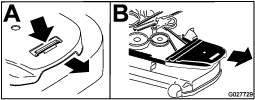
-
Use a ratchet in the square hole in the idler arm to remove the tension on the idler spring (Figure 73).
-
Remove the belt from the mower-deck pulleys.
-
Remove the belt guide on the spring loaded idler arm shown in Figure 73.
-
Remove the existing belt.
-
Install the new belt around the mower pulleys and the clutch pulley under the engine (Figure 73).
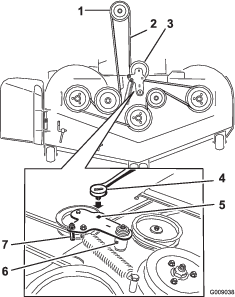
-
Install the belt guide on the idler arm shown in Figure 73.
-
Using the ratchet in the square hole, install the idler spring (Figure 73).
Make sure that the spring ends are seated in the anchor grooves.
-
Install the belt covers (Figure 74).

Replacing the Hydraulic Pump-Drive Belt
-
Disengage the PTO and set the parking brake.
-
Shut off the engine, remove the key, and wait for all moving parts to stop before leaving the operating position.
-
Remove mower belt. Refer to Replacing the Mower Belt.
-
Raise the machine and support it with jack stands (Figure 75).
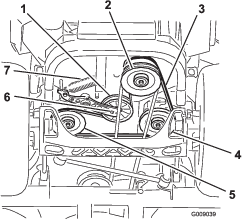
-
Use a ratchet in the square hole in the idler arm to remove the idler spring (Figure 75).
-
Unhook the idler spring from the frame (Figure 75).
-
Remove the belt from the hydraulic-unit-drive pulleys and the engine pulley
-
Install the new belt around engine pulley and the 2 drive pulleys.
-
Using a ratchet in the square hole in the idler arm, install the idler spring to the frame (Figure 75).
-
Install the mower belt. Refer to Replacing the Mower Belt.
Controls System Maintenance
Adjusting the Control-Handle Position
There are 2 height positions for the control levers; high and low. Remove the bolts to adjust the height for the operator.
-
Disengage the PTO, move the motion-control levers to the NEUTRAL-LOCK position, and set the parking brake.
-
Shut off the engine, remove the key, and wait for all moving parts to stop before leaving the operating position.
-
Loosen the bolts and flange nuts installed in the levers (Figure 76).
-
Align the levers front to rear position by bring the levers together to the neutral position and slide them until they are aligned, then tighten the bolts (Figure 77).
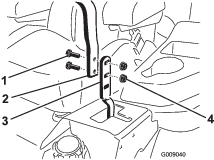
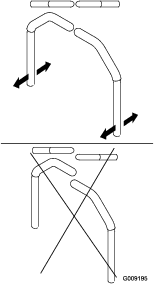
Adjusting the Motion-Control Linkage
Located on either side of the fuel tank, below the seat are the pump-control linkages. Rotating the pump linkage with a 1/2 inch wrench allows fine-tuning adjustments so that the machine does not move in neutral. Any adjustments should be made for neutral positioning only.
Warning
The engine must be running and the drive wheels must be turning so that you can perform the motion-control adjustment. Contact with moving parts or hot surfaces may cause personal injury.
Keep your fingers, hands, and clothing clear of rotating components and hot surfaces.
-
Prior to starting the engine, push the deck-lift pedal and remove the height-of-cut pin. Lower the deck to the ground.
-
Raise the rear of machine up and support it with jack stands (or equivalent support) just high enough to allow the drive wheels to turn freely.
-
Remove the electrical connection from the seat safety switch, located under the bottom cushion of the seat.
Note: The switch is a part of the seat assembly.
-
Temporarily install a jumper wire across the terminals in the connector of the main wiring harness.
-
Start the engine.
Important: Before you can start the engine, the brake must be engaged and the motion-control levers must be out. You do not need to be in the seat because of the jumper wire is in use. Run the engine at full throttle and release the brake.
-
Run the machine at least 5 minutes with the motion-control levers at full forward speed to bring the hydraulic fluid up to operating temperature.
Note: The motion-control lever must be in neutral while making any necessary adjustments.
-
Bring the motion-control levers into the NEUTRAL position.
-
Adjust the length of the pump-control rod by rotating the double nuts on the rod in the appropriate direction until the wheels slightly creep in reverse (Figure 78).
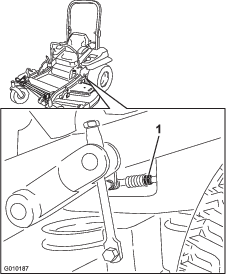
-
Move the motion-control levers to the REVERSE position, and while applying slight pressure to the lever, allow the reverse indicator springs to bring the levers back to neutral.
Note: The wheels must stop turning or slightly creep in reverse.
-
Shut off the machine.
-
Remove the jumper wire from the wire harness and plug the connector into the seat switch.
-
Remove the jack stands.
-
Raise the deck and install the height-of-cut pin.
-
Check that the machine does not creep in neutral with the parking brakes disengaged.
Adjusting the Motion-Control Damper
You can adjust the top damper-mounting bolt to obtain the desired motion-control lever resistance. Refer to Figure 79 for mounting options.
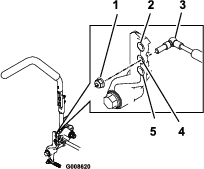
Adjusting the Motion-Control Neutral-Lock Pivot
You can adjust the flanged nut to obtain the desired motion-control lever resistance when moving it to the NEUTRAL-LOCK position. See Figure 80 for adjustment options.
-
Loosen the jam nut.
-
Tighten or loosen the flanged nut to the desired feel.
-
For more resistance, tighten the flanged nut.
-
For less resistance, loosen the flanged nut
-
-
Tighten the jam nut.
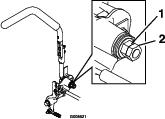
Hydraulic System Maintenance
Servicing the Hydraulic System
Hydraulic Fluid Type: Toro® HYPR-OIL™ 500 hydraulic fluid or Mobil® 1 15W-50.
Important: Use the hydraulic fluid specified. Other fluids could damage the hydraulic system.
Hydraulic System Capacity: 1.5 L (52 oz) per side with filter change
Checking the Hydraulic-Fluid Level
| Maintenance Service Interval | Maintenance Procedure |
|---|---|
| Every 50 hours |
|
-
Position the machine on a level surface.
-
Disengage the PTO, move the motion-control levers to the NEUTRAL-LOCK position, and set the parking brake.
-
Shut off the engine, remove the key, and wait for all moving parts to stop before leaving the operating position.
-
Allow the engine and hydraulic system to cool for 10 minutes.
Note: The fluid level on the dipstick will be incorrect if you check the fluid when the machine is hot.
-
Move the seat forward.
-
Clean the area around the dipsticks of the hydraulic system reservoirs (Figure 81).
-
Remove 1 dipstick from the hydraulic reservoir (Figure 81).
-
Wipe the dipstick off and thread the dipstick into the reservoir.
-
Remove the dipstick and look at the end (Figure 81).
Note: If the fluid level is at the Add mark, slowly pour only enough fluid into the hydraulic reservoir to raise the level to the Full or H line.
Important: Do not overfill the hydraulic units with fluid as damage may occur. Do not run the machine with the fluid below the Add mark.
-
Install the dipstick.
-
Repeat this procedure for the opposite dipstick.
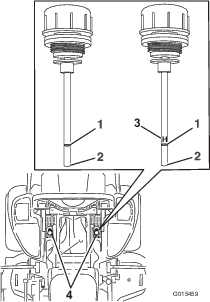
Warning
Hydraulic fluid escaping under pressure can penetrate skin and cause injury.
-
If hydraulic fluid is injected into the skin, it must be surgically removed within a few hours by a doctor familiar with this type of injury. Gangrene may result if this is not done.
-
Keep body and hands away from pin-hole leaks or nozzles that eject high-pressure hydraulic fluid.
-
Use cardboard or paper to find hydraulic-fluid leaks.
-
Safely relieve all pressure in the hydraulic system before performing any work on the hydraulic system.
-
Make sure that all hydraulic hoses and lines are in good condition and that all hydraulic connections and fittings are tight before applying pressure to the hydraulic system.
-
Replacing the Hydraulic Filters and Hydraulic Fluid
| Maintenance Service Interval | Maintenance Procedure |
|---|---|
| After the first 250 hours |
|
| Every 250 hours |
|
| Every 500 hours |
|
To replace the hydraulic fluid, you must remove the filters. Replace both filters at the same time; refer to Servicing the Hydraulic System for the fluid specifications.
-
Disengage the blade-control switch (PTO), move the motion-control levers to the NEUTRAL-LOCK position, and set the parking brake.
-
Shut off the engine, remove the key, and wait for all moving parts to stop before leaving the operating position.
-
Raise the machine and support it with jack stands (Figure 82).
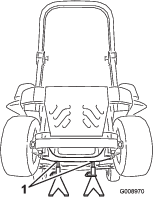
-
Remove both the mower belt and the pump-drive belt; refer to Replacing the Mower Belt and Replacing the Hydraulic Pump-Drive Belt.
Note: This prevents fluid from contacting the belts.
-
Place a drain pan under the filter, remove the old filter, and wipe the surface clean (Figure 83).

-
Apply a thin coat of hydraulic fluid to the rubber gasket on the replacement filter (Figure 83).
-
Install the replacement hydraulic filter.
-
Install the pump-drive belt and the mower belt.
-
Remove the jack stands and lower the machine (Figure 82).
-
Add oil to the hydraulic reservoir and check for any leaks.
-
Clean up any spilled fluid.
-
Start the engine and let it run for about 2 minutes to purge air from the system.
-
Shut off the engine and check for leaks.
-
Check the fluid level while the fluid is cold.
-
If required, add fluid to the hydraulic reservoir.
Note: Do not overfill.
Mower Deck Maintenance
Leveling the Mower Deck
Setting up the Machine
Note: Ensure the mower deck is level before matching the height of cut (HOC).
-
Move the machine to a flat surface.
-
Disengage the blade-control switch (PTO), move the motion-control levers to the NEUTRAL-LOCK position, and set the parking brake.
-
Shut off the engine, remove the key, and wait for all moving parts to stop before leaving the operating position.
-
Check tire pressure of the tires. If needed, adjust the pressure to 90 kPa (13 psi).
-
Position the mower to the 76 mm (3 inch) height-of-cut position.
Leveling the Deck
-
Move the mower on a flat surface.
-
Shut off the engine, wait for all moving parts to stop, remove key, and engage the parking brake.
-
Check the tire pressure in the drive tires. The proper inflation pressure for tires is 90 kPa (13 psi). Adjust the pressure if necessary.
-
Position the transport lock in the latching position.
-
Push the deck-lift pedal all the way forward so that the deck latches at the 14 cm (5-1/2 inch) transport position (Figure 84).

-
Insert the height-of-cut pin into the 7.6 cm (3 inch) position.
-
Release the transport lock and allow the deck to lower to the cutting height.
-
Raise the discharge chute.
-
On both sides of the deck, measure from the level surface to the front tip of the blade (Postion A). The measurement should read 7.6 mm (3 inches) (Figure 85).
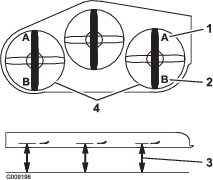
-
If needed, loosen the locknut on the side of the yoke and the jam nut on top. Fine tune the screw adjuster by turning it to attain the 7.6 mm (3 inch) height (see Figure 86).
To increase the height, turn the adjuster screw clockwise; to decrease the height, turn it counterclockwise.
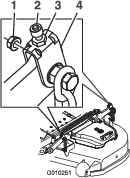
-
If the front deck links do not have enough adjustment to achieve accurate cut height, you can use the single-point adjustment to gain more adjustment.
-
To adjust the single-point system, loosen the 2 bolts at the bottom of the height-of-cut plate. Refer to Figure 87.

-
If the deck is too low, tighten the single point adjustment bolt by rotating it clockwise. If the deck is too high, loosen the single point adjustment bolt by rotating it counterclockwise (Figure 88).
Note: Loosen or tighten the single-point adjustment bolt enough to move the height-of-cut plate mounting bolts at least 1/3 the length of the available travel in their slots. This should regain some up and down adjustment on each of the 4 deck links.

-
Tighten the 2 bolts at the bottom of the height-of-cut plate (Figure 87). Torque the bolts to 37 to 45 N∙m (27 to 33 ft-lb).
Note: For most conditions, adjust the back blade tip 6.4 mm (1/4 inch) higher than the front tip.
-
On both sides of the deck, measure from the level surface to the back tip of the blade (Postion B). The measurement should read 8.3 cm (3-1/4 inches) (Figure 85).
-
Fine-tune the screw adjuster by turning it to attain to the 8.3 mm (3-1/4 inch) height (Figure 86).
To increase the height, turn the adjustment nut clockwise; to decrease the height, turn it counterclockwise.
-
Measure until all 4 sides are the correct height. Tighten all the nuts on the deck-lift arm assemblies.
-
Lower the discharge chute.
Servicing the Cutting Blades
Maintain sharp blades throughout the cutting season, because sharp blades cut cleanly without tearing or shredding the grass blades. Tearing and shredding turns grass brown at the edges, which slows growth and increases the chance of disease.
Check the cutter blades daily for sharpness and for any wear or damage. File down any nicks and sharpen the blades as necessary. If a blade is damaged or worn, replace it immediately with a genuine Toro replacement blade. For convenient sharpening and replacement, keep extra blades on hand.
Danger
A worn or damaged blade can break, and a piece of the blade could be thrown at you or bystanders, resulting in serious personal injury or death.
-
Inspect the blade periodically for wear or damage.
-
Replace a worn or damaged blade.
Before Inspecting or Servicing the Blades
Park the machine on a level surface, disengage the blade-control switch (PTO), and set the parking brake. Turn the ignition key to off. Remove the key.
Inspecting the Blades
| Maintenance Service Interval | Maintenance Procedure |
|---|---|
| Before each use or daily |
|
-
Inspect the cutting edges (Figure 89). If the edges are not sharp or have nicks, remove and sharpen the blades. Refer to Sharpening the Blades.
-
Inspect the blades, especially the curved area (Figure 89). If you notice any damage, wear, or a slot forming in this area (Figure 89), immediately install a new blade.
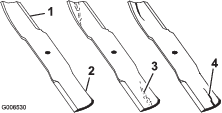
Checking for Bent Blades
-
Disengage the blade-control switch (PTO), move the motion-control levers to the NEUTRAL-LOCK position, and set the parking brake.
-
Shut off the engine, remove the key, and wait for all moving parts to stop before leaving the operating position.
-
Rotate the blades until the ends face forward and backward (Figure 90).
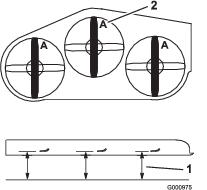
-
Measure from a level surface to the cutting edge, position A, of the blades (Figure 90). Note this dimension.
-
Rotate the opposite ends of the blades forward.
-
Measure from a level surface to the cutting edge of the blades at the same position as in step 3 above. The difference between the dimensions obtained in steps 3 and 5 must not exceed 1/8 inch (3 mm). If this dimension exceeds 1/8 inch (3 mm), the blade is bent and must be replaced; refer to Removing the Blades and Sharpening the Blades.
Warning
A blade that is bent or damaged could break apart and could seriously injure or kill you or bystanders.
-
Always replace a bent or damaged blade with a new blade.
-
Never file or create sharp notches in the edges or surfaces of a blade.
-
Removing the Blades
Replace the blades if they hit a solid object or if a blade is out of balance or bent. To ensure optimum performance and continued safety conformance of the machine, use genuine Toro replacement blades. Replacement blades made by other manufacturers may result in non-conformance with safety standards.
-
Hold the blade end using a rag or thickly-padded glove.
-
Remove the blade bolt, curved washer, and blade from the spindle shaft (Figure 91).
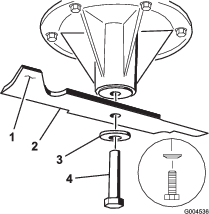
Sharpening the Blades
-
Use a file to sharpen the cutting edge at both ends of the blade (Figure 92).
Note: Maintain the original angle.
Note: The blade retains balance if you remove the same amount of material from both cutting edges.

-
Check the balance of the blade by putting it on a blade balancer (Figure 93).
Note: If the blade stays in a horizontal position, the blade is balanced and you can use it.

-
If the blade is not balanced, file some metal off the end of the sail area only (Figure 91).
-
Repeat this procedure until the blade is balanced.
Installing the Blades
-
Install the blade onto the spindle shaft (Figure 94).
Important: The curved part of the blade must point upward toward the inside of the mower to ensure proper cutting.
-
Install the spring disk and blade bolt (Figure 94).
Note: Install the spring-disk cone toward the bolt head (Figure 94).
-
Torque the blade bolt to 115 to 150 N∙m (85 to 110 ft-lb).

Removing the Mower Deck
Lock out the spring-loaded deck arms before servicing or removing the mower deck.
Warning
Deck-lift arm assemblies have stored energy. Removing the deck with out releasing the stored energy can cause serious injury or death.
Do not attempt to disassemble the deck from the front frame without locking out the stored energy.
-
Shut off the engine, wait for all of the moving parts to stop, remove the key, and engage the parking brake.
-
Remove the height-adjustment pin and lower the deck to the ground.
-
Place the height adjustment pin in the 7.6 cm (3 inch) cutting-height location.
Note: This locks the deck-lift arms in the lowest position when the deck is removed and the stored energy in the deck spring is released.
-
Remove the belt covers.
-
Lift up the floor pan and insert a ratchet into the square hole in the deck idler (Figure 95).
-
Rotate the deck idler clockwise and remove the mower belt (Figure 95).

-
Remove and retain the hardware on both sides of the deck as shown in Figure 96.
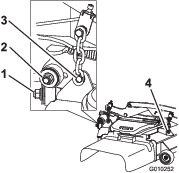
-
Raise the deck struts and secure them in the raised position.
-
Slide the deck out to the right side of the machine.
Replacing the Grass Deflector
Warning
An uncovered discharge opening could allow the lawn mower to throw objects at you or bystanders, resulting in serious injury. Also, contact with the blade could occur.
Never operate the lawn mower unless you install a cover plate, mulch plate, grass deflector, or bagger.
-
Remove the locknut, bolt, spring, and spacer holding the deflector to the pivot brackets (Figure 97).

-
Remove damaged or worn grass deflector.
-
Place spacer and spring onto the grass deflector. Place a J-end of spring behind deck edge.
Note: Ensure that a J-end of spring is installed behind deck edge before installing the bolt as shown in Figure 97.
-
Install the bolt and nut.
-
Place a J-hook end of spring around grass deflector (Figure 97).
Important: The grass deflector must be able to rotate. Lift the deflector up to the full open position and ensure that it rotates into the full down position.
Cleaning
Cleaning under the Mower
| Maintenance Service Interval | Maintenance Procedure |
|---|---|
| Before each use or daily |
|
-
Disengage the blade-control switch (PTO), move the motion-control levers to the NEUTRAL-LOCK position, and set the parking brake.
-
Shut off the engine, remove the key, and wait for all moving parts to stop before leaving the operating position.
-
Raise the mower to the transport position.
Disposing of Waste
Engine oil, batteries, hydraulic fluid, and engine coolant are pollutants to the environment. Dispose of these according to your state and local regulations.
Storage
Cleaning and Storage
-
Disengage the power takeoff (blade-control switch (PTO), set the parking brake, and turn the ignition key to the OFF position. Remove the key.
-
Remove grass clippings, dirt, and grime from the external parts of the entire machine, especially the engine and hydraulic system. Clean dirt and chaff from the outside of the engine cylinder head fins and blower housing.
Important: You can wash the machine with mild detergent and water. Do not pressure-wash the machine. Avoid excessive use of water, especially near the control panel, engine, hydraulic pumps, and motors.
-
Check the brake; refer to Brake Maintenance.
-
Service the air cleaner; refer to Servicing the Air Cleaner.
-
Grease the machine; refer to Greasing the Mower.
-
Change the crankcase oil; refer to Changing the Engine Oil.
-
Check the tire pressure; refer to Checking the Tire Pressure.
-
Change the hydraulic filters; refer to Replacing the Hydraulic Filters and Hydraulic Fluid.
-
Charge the battery; refer to Charging the Battery.
-
Scrape any heavy buildup of grass and dirt from the underside of the mower, then wash the mower with a garden hose.
Note: Run the machine with the blade-control switch (PTO) engaged and the engine at high idle for 2 to 5 minutes after washing.
-
Check the condition of the blades; refer to Servicing the Cutting Blades.
-
Prepare the machine for storage when non-use occurs over 30 days. Prepare the machine for storage as follows:
-
Add a petroleum based stabilizer/conditioner to fuel in the tank. Follow mixing instructions from the stabilizer manufacturer. Do not use an alcohol-based stabilizer (ethanol or methanol).
Note: A fuel stabilizer/conditioner is most effective when mixed with fresh fuel and used at all times.
-
Run the engine to distribute conditioned fuel through the fuel system (5 minutes).
-
Shut off the engine, allow it to cool, and drain the fuel tank; refer to Servicing the Fuel Tank in the Maintenance Section.
-
Start the engine and run it until it stops.
-
Dispose of fuel properly. Recycle according to local codes.
Important: Do not store stabilizer/conditioned fuel over 90 days.
-
-
Check and tighten all bolts, nuts, and screws. Repair or replace any part that is damaged.
-
Paint all scratched or bare metal surfaces. Paint is available from your Authorized Service Dealer.
-
Store the machine in a clean, dry garage or storage area.
-
Remove the key from the ignition switch and keep it out of reach of children or other unauthorized users.
-
Cover the machine to protect it and keep it clean.
Troubleshooting
| Problem | Possible Cause | Corrective Action |
|---|---|---|
| The starter does not crank. |
|
|
| The engine does not start, starts hard, or fails to keep running. |
|
|
| The engine loses power. |
|
|
| The engine overheats. |
|
|
| The mower pulls left or right (with levers fully forward). |
|
|
| The machine does not drive. |
|
|
| There is abnormal vibration. |
|
|
| Mowing is resulting in uneven cutting height. |
|
|
| The blades do not rotate. |
|
|
| The clutch does not engage. |
|
|
Schematics
Electrical Schematic

